Introduction
Financial audits stand as the cornerstone of transparent and accurate financial reporting, providing critical insights into an organization's financial health and compliance with regulatory standards. These audits, whether conducted internally to enhance risk management and governance or externally to provide an unbiased review of financial statements, are indispensable for maintaining stakeholder trust and operational integrity.
The landscape of financial audits is evolving, particularly with the introduction of the International Standard on Auditing for Audits of Financial Statements of Less Complex Entities (ISA for LCE) by the International Auditing and Assurance Standards Board (IAASB). This pivotal development tailors the audit process to meet the needs of smaller and less complex entities, ensuring they benefit from the same rigorous standards as larger organizations.
Audit committees, especially in sectors like banking, must navigate shifting regulatory expectations, such as the Federal Deposit Insurance Corp.'s (FDIC) proposals for heightened supervision of large banks. Continuous education and access to industry expertise are crucial for these committees to fulfill their oversight roles effectively.
Real-world examples, including recent updates from the Federal Reserve Board and the Office of the Comptroller of the Currency, underline the dynamic nature of regulatory environments and the necessity for organizations to stay informed and agile. These insights collectively underscore the importance of financial audits in fostering transparency, compliance, and robust financial practices.
Understanding Financial Audits
Monetary reviews are thorough assessments of a company's fiscal reports and activities, guaranteeing both precision and adherence to regulations. These evaluations offer interested parties a clear perspective on the organization's economic status. They can be internal or external, each serving distinct purposes but collectively enhancing the integrity of financial practices.
Internal reviews concentrate on assessing and enhancing the efficiency of risk management, control, and governance processes. They are crucial for recognizing internal inefficiencies and ensuring that the entity follows its policies and procedures. Conversely, external evaluations, carried out by impartial entities, deliver an unbiased review of the financial statements, providing reasonable assurance that the statements are devoid of significant inaccuracies.
The introduction of the International Standard on Auditing for Audits of Financial Statements of Less Complex Entities (ISA for LCE) by the International Auditing and Assurance Standards Board (IAASB) is a significant development. This new standalone standard addresses the unique examination needs of smaller and less complex entities, ensuring they receive the same level of assurance as larger organizations. 'Constructed on the basis of the broadly accepted International Standards on Auditing (ISAs), ISA for LCE is customized to fulfill the particular needs of less complex enterprises, thus improving the significance and efficacy of evaluations for these organizations.'.
Efficient review panels play a crucial role in corporate governance, especially in the banking sector. As regulatory expectations continue to evolve, such as the recent proposals by the Federal Deposit Insurance Corp. (FDIC) to heighten supervision standards for banks with over $10 billion in assets, review committees must be equipped with the right resources and support. Continuous training and access to industry-specific knowledge are vital for these committees to fulfill their oversight responsibilities effectively.
Real-world case studies and recent regulatory updates highlight the dynamic nature of audits. For instance, the Federal Reserve Board's announcement regarding the termination of the Bank Term Funding Program (BTFP) underscores the importance of staying informed about regulatory changes that impact monetary institutions. Furthermore, the Office of the Comptroller of the Currency's (OCC) proposal to revise the merger approval process for national banks reflects ongoing efforts to enhance regulatory frameworks and ensure strong economic practices.
In summary, monetary evaluations are essential for upholding clarity, adherence to regulations, and confidence among stakeholders. By adapting to new standards like ISA for LCE and staying informed about regulatory changes, organizations can enhance their economic integrity and governance.

Preparation Steps for a Financial Audit
Efficient preparation is the cornerstone of a successful monetary audit. This process begins with a thorough understanding of the entity's reporting needs, including key factors such as the deadline for reporting and the basis of accounting required. Common bases include Generally Accepted Accounting Principles (GAAP) and other comprehensive bases such as the income tax basis of accounting. These requirements are often found in governing documents like operating agreements or loan agreements if mandated by a lender.
Collecting all pertinent monetary documents is essential. This encompasses monetary reports, prior examination documents, and supporting records for transactions. For instance, M&T Bank, with its long history of community-focused banking and rigorous compliance standards, showcases the importance of meticulous documentation and preparation. The bank's compliance with strict regulatory standards guarantees a seamless examination and safeguards against possible financial and reputational threats.
Establishing a clear timeline is equally important. A well-defined timeline assists in managing the evaluation efficiently, ensuring that all necessary documents and records are examined thoroughly. As stated by the International Auditing and Assurance Standards Board (IAASB), following a systematic and balanced evaluation method, particularly for smaller organizations, can simplify the examination and offer reasonable assurance.
By adhering to these steps, organizations can not only promote a smoother examination but also ensure compliance with monetary regulations and reporting standards, ultimately contributing to their economic stability and growth.
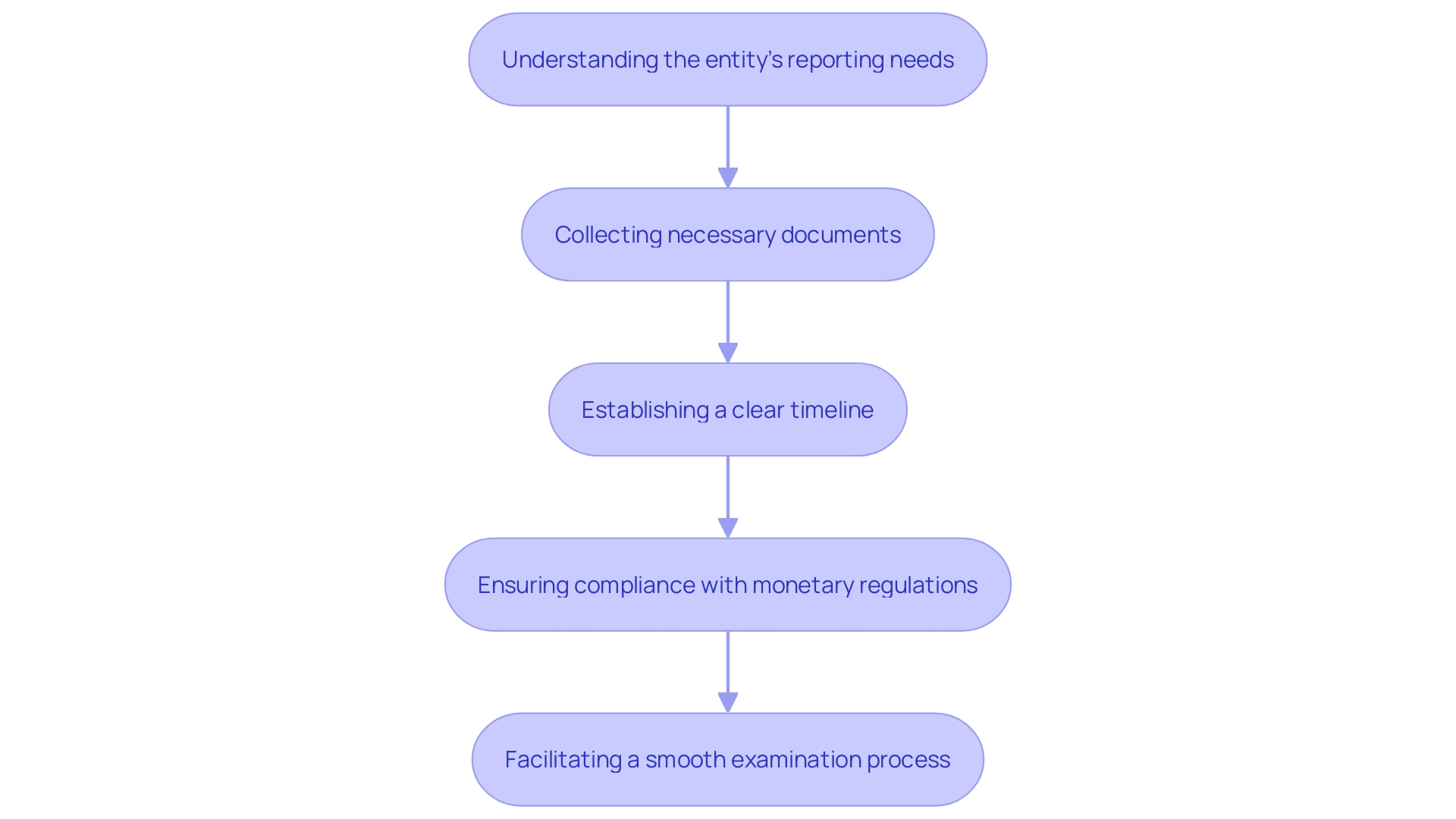
Step 1: Organize Financial Records
Begin by gathering all financial records, such as invoices, receipts, bank statements, and ledgers. Utilize automation tools to streamline this process, ensuring efficiency and accuracy. Organize these documents either chronologically or by category to facilitate a seamless audit. The introduction of electronic statements has transformed record-keeping, making it easier to compile and access necessary data. Ensure all records are complete and easily accessible, as this will significantly assist auditors in reviewing and verifying monetary information. Monetary reports such as cash flow statements offer a comprehensive perspective on a company's economic well-being, recording all cash inflows and outflows. This comprehensive documentation supports auditors in evaluating the accuracy and integrity of monetary data, thus ensuring compliance with reporting standards.
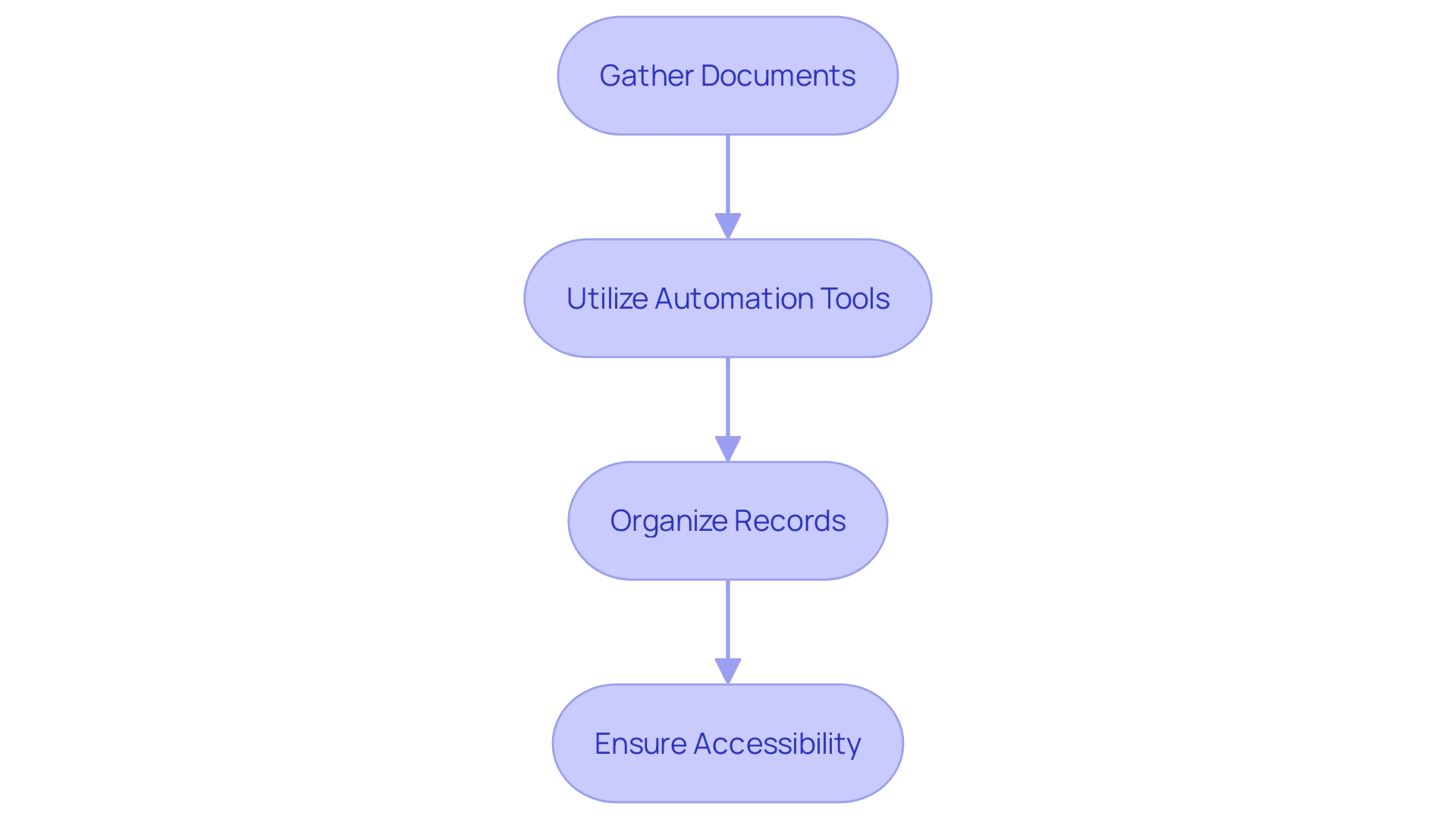
Step 2: Review Internal Controls
Reinforcing internal regulations is vital for dependable monetary reporting and efficient review procedures. Begin by evaluating current controls in areas like cash management, procurement, and reporting. For instance, the Treasury Board of Canada Secretariat has introduced new guidelines to enhance procurement controls, ensuring compliance with laws and policies. These measures help mitigate risks, foster trust, and improve operational efficiency. As KPMG emphasizes, utilizing advanced technologies like AI can offer deeper insights and improve the reliability of monetary statements. By tackling shortcomings in internal controls, organizations can guarantee more precise and reliable financial reporting, facilitating a smoother and more effective evaluation.
Step 3: Prepare Your Team
Make certain your finance and accounting teams are entirely ready for the examination by notifying them about the procedure, roles, and expectations. Conduct comprehensive training sessions, focusing on the effective provision of required documentation and answering auditor queries. Real-world experience from the Financial Reporting Council (FRC) highlights the significance of having clear, organized content, as users often struggle with navigation and finding current versions of codes and guidance. Equipping your team with proper resources and training can mitigate these challenges. The International Auditing and Assurance Standards Board (IAASB) recently released the ISA for LCE, highlighting the necessity for customized evaluation methods for smaller entities. This highlights the significance of personalized training to address particular assessment requirements. Investing in your team's preparedness ensures compliance and efficiency, aligning with evolving standards and regulatory expectations.
Step 4: Conduct a Pre-Audit Review
Carrying out an internal examination of financial statements and supporting documents is crucial prior to the evaluation. This involves reconciling accounts, ensuring adherence to accounting standards, and addressing any discrepancies. Such a thorough pre-examination review helps identify potential issues, allowing for timely corrections and smoother review proceedings.
The introduction of the International Standard on Auditing for Audits of Financial Statements of Less Complex Entities (ISA for LCE) by the International Auditing and Assurance Standards Board (IAASB) underscores the importance of these preparatory steps. This new standard adapts the review procedure to the particular requirements of smaller and less complex entities, aiming to offer reasonable assurance while acknowledging the distinct challenges these groups encounter.
By proactively managing these steps, entities can mitigate risks and ensure compliance, aligning their practices with globally respected standards. This approach not only enhances the efficiency of the evaluation but also builds stakeholder confidence in the organization's financial reporting.
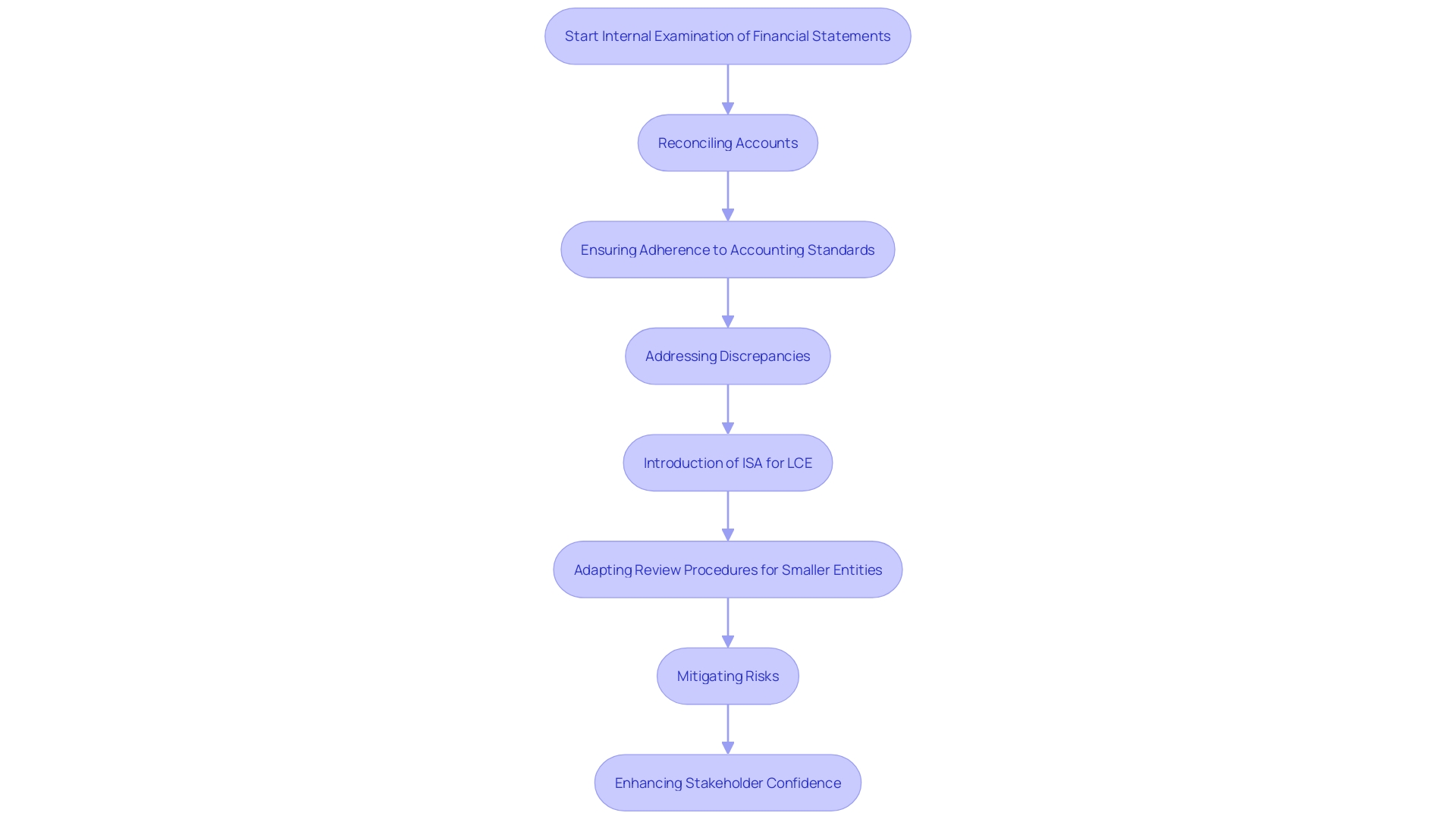
Step 5: Communicate with Your Auditor
Developing robust communication channels with your auditor is critical. Start by clearly outlining the review timeline, identifying key areas of focus, and addressing any specific concerns. This proactive method guarantees both parties stay in sync and promotes smoother cooperation throughout the evaluation.
Incorporating a risk-based approach for quality management, as highlighted in the 2024 Yellow Book, can further improve the assessment's effectiveness. The book highlights the shift from traditional quality control to a more dynamic quality management system, adaptable to organizations of all sizes and complexities. This modern approach prioritizes risk identification and management, ensuring audit quality is upheld.
Accounting firms play a key role in this process by offering essential monetary services such as auditing. Their expertise helps businesses maintain accurate, compliant, and credible monetary practices. As noted, 'Accounting firms play a very important role in the business world by providing key services such as bookkeeping, tax preparation, auditing, and consulting, helping businesses manage their resources effectively.'
Furthermore, data indicates that 94% of entities utilize evaluation outcomes to promote enhancements in financial practices, highlighting the importance of transparent, continuous dialogue between assessors and companies. Real-world examples, such as the National Council for the Blind of Ireland and Hadley, demonstrate how structured communication and quality management systems can lead to significant, positive impacts in organizational operations and compliance.
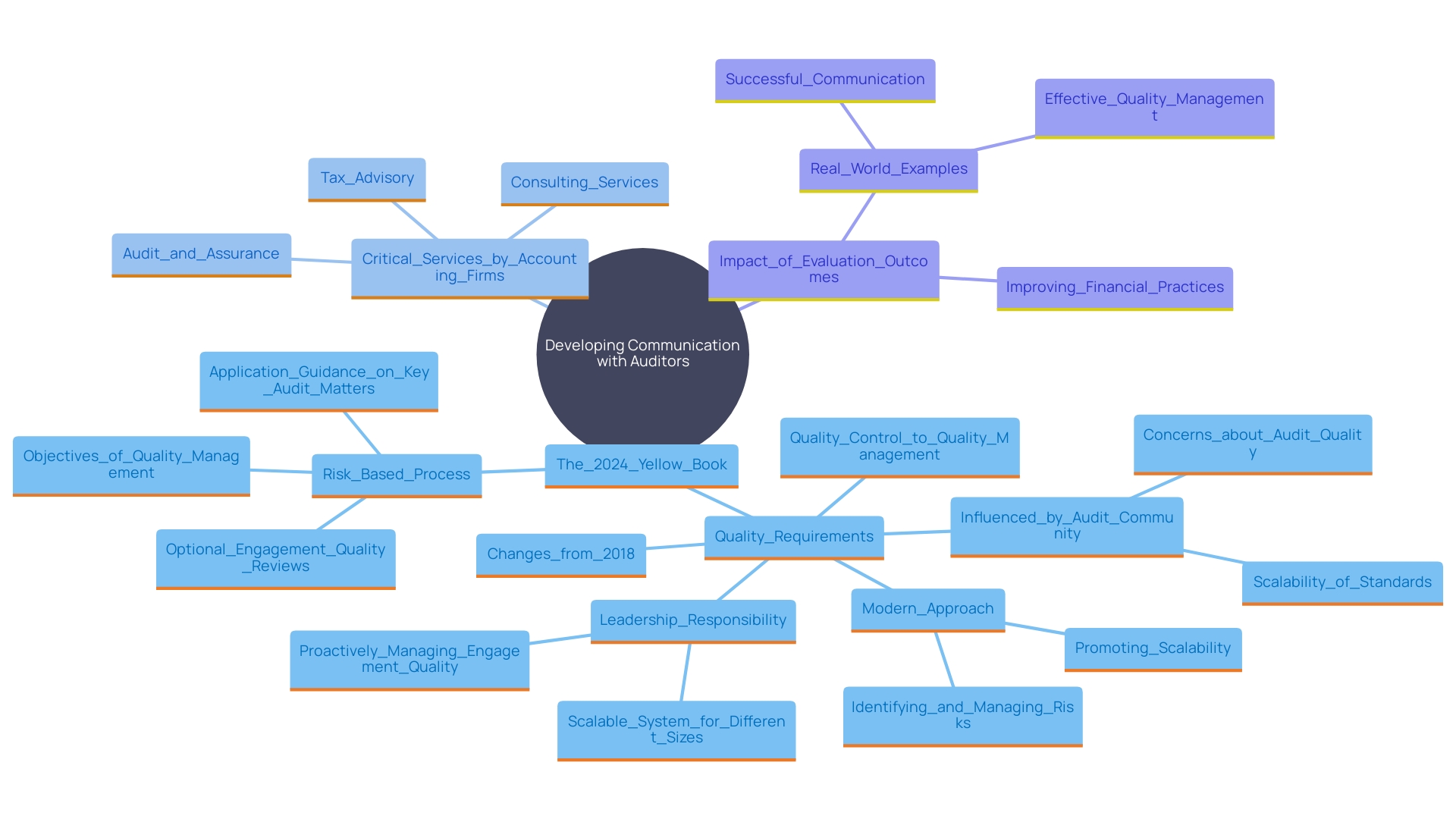
The Audit Process: Planning, Execution, and Reporting
The audit process is structured into three pivotal phases: planning, execution, and reporting. In the planning phase, auditors meticulously develop a strategy by conducting a comprehensive risk assessment. This step is crucial for identifying potential vulnerabilities and high-risk areas within the organization.
During the execution phase, auditors collect substantial evidence through rigorous testing and verification of monetary data. This phase involves a detailed examination of monetary statements, policy compliance, and operational concerns. According to a global survey by the Workforce Lab at Slack, effective use of AI tools during this phase can enhance productivity and accuracy, although there is a notable gap between executive urgency and employee adoption.
Finally, in the reporting phase, auditors compile their findings into a detailed report. This report not only outlines the results but also provides actionable recommendations to address identified issues. The Department of Defense (DOD) has shown that remediation efforts can result in substantial financial and operational advantages, including cost reductions, enhanced data precision, and more streamlined activities. A clear understanding of these phases and thorough preparation can greatly enhance the efficiency and effectiveness of the evaluation process.
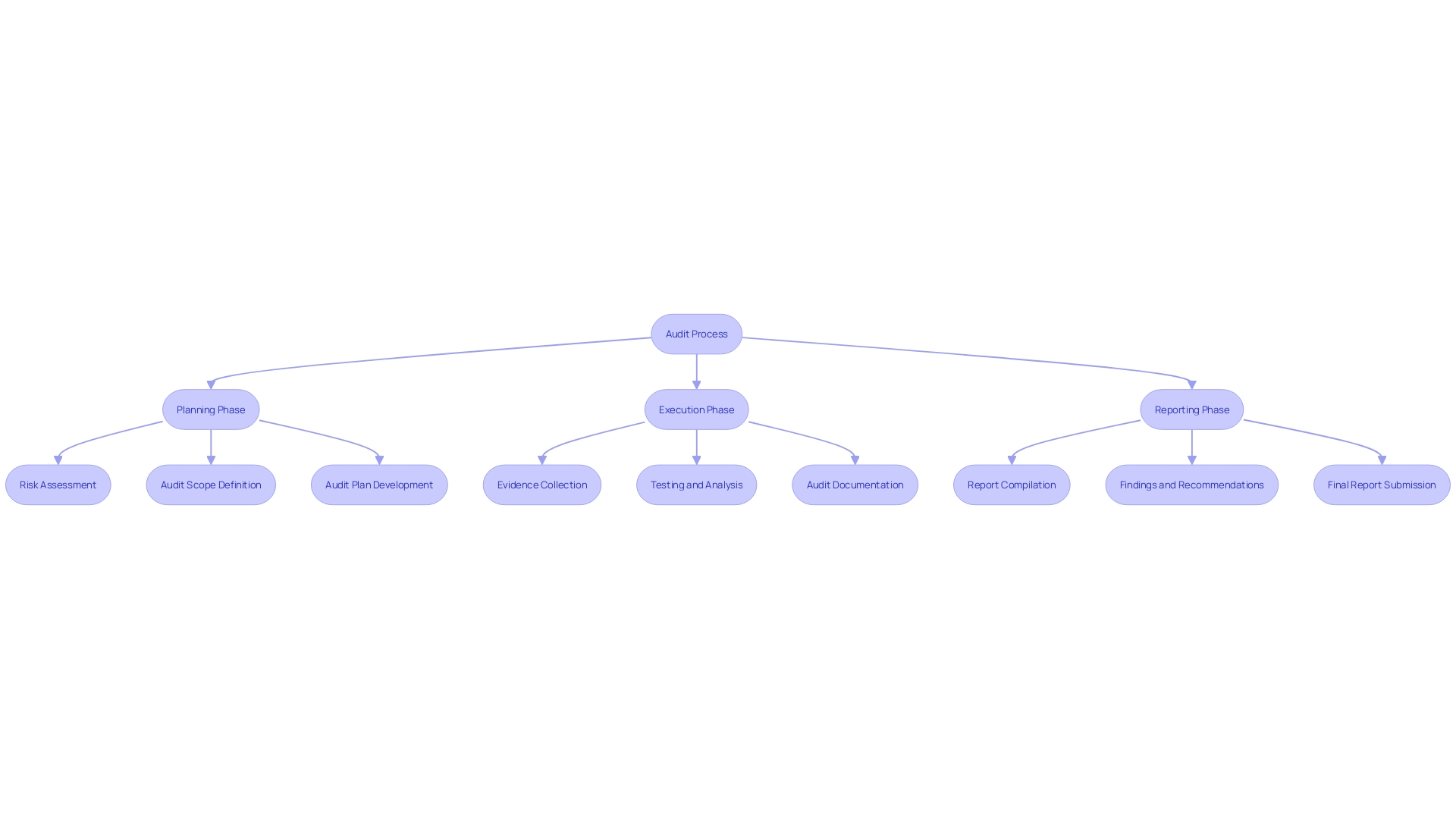
Audit Planning: Risk Assessment and Strategy Development
Efficient review planning starts with a strong risk evaluation to identify areas that require more detailed examination. This involves evaluating the unique contexts and economic intricacies of the entity being audited. For instance, the International Auditing and Assurance Standards Board (IAASB) has recently introduced the International Standard on Auditing for Audits of Financial Statements of Less Complex Entities (ISA for LCE). This new standard provides a customized method that corresponds with the particular evaluation needs of smaller, less complex enterprises, ensuring a proportionate and efficient review process.
By adopting a strategy that prioritizes high-risk areas, auditors can ensure that their resources are utilized most effectively. This strategic focus not only addresses the critical aspects of financial statements but also enhances the overall quality and trustworthiness of the evaluation. Recent updates in regulatory standards, such as the Federal Deposit Insurance Corp. (FDIC) proposal to heighten supervision standards for state nonmember banks, underscore the importance of staying abreast of evolving compliance requirements.
Furthermore, forming a capable oversight panel provided with the appropriate resources and education is essential. The board of directors must continuously support the review committee to adapt to new regulatory landscapes and emerging risk factors. This commitment is essential to upholding strict corporate governance and guaranteeing that the evaluation process is both effective and thorough.
Ultimately, conducting a thorough risk evaluation, coupled with a strategic and well-supported review committee, allows for a meticulous examination of financial statements. This method not only strengthens the review's integrity but also aligns with stakeholders' expectations for transparency and accountability.
The Execution Phase: Gathering Evidence and Testing Controls
During the execution phase, auditors gather evidence through various methods, including sampling, observation, and inquiry. This phase is critical for assessing the effectiveness of internal controls in preventing errors or fraud. For example, based on the 2024 Yellow Book, the transition from quality control to quality management highlights a risk-based approach to guarantee the quality of evaluations. Recording results precisely is crucial for producing strong evaluation reports that can result in considerable economic and operational advantages. The Department of Defense (DOD) has shown this through its financial statement evaluations, which led to cost savings, improved asset management, and greater efficiency. Precise documentation bolsters these results by offering a dependable foundation for evaluations and suggestions.
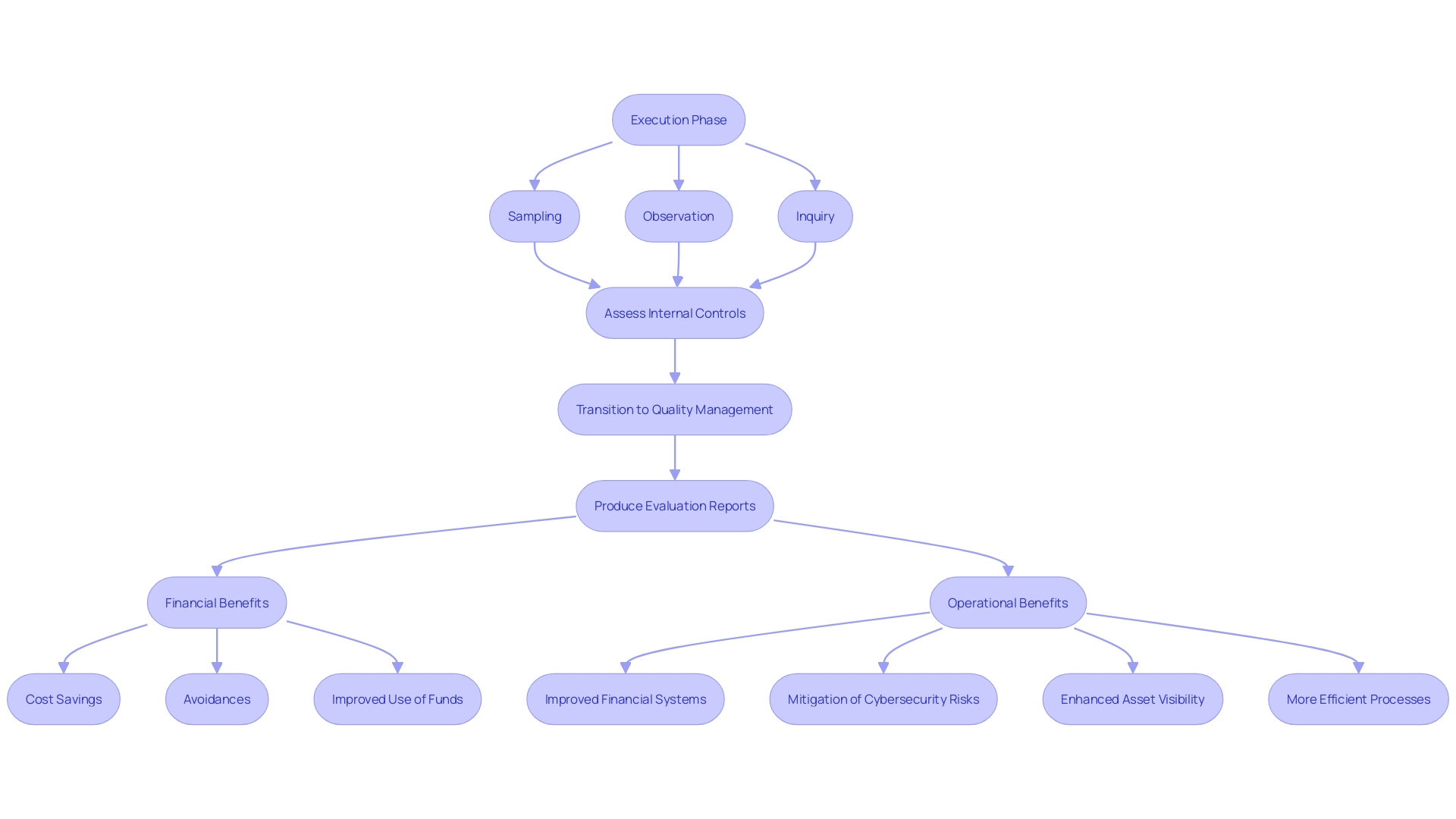
Audit Sampling Techniques
Audit sampling entails selecting a subset of transactions that can represent the entire dataset, allowing auditors to draw conclusions without examining every single transaction. Techniques such as random sampling and stratified sampling are pivotal in this process. Random sampling ensures each transaction has an equal chance of being selected, providing a comprehensive overview. Stratified sampling, on the other hand, involves dividing the population into subgroups and sampling each subgroup, which enhances accuracy. Understanding these methodologies is essential for auditors to ensure the reliability of their conclusions. As Kathleen Hamm, a former Board Member of the PCAOB, emphasized, establishing effective quality control systems and audit quality metrics is crucial in rebuilding trust in the audit sector, especially following high-profile scandals.

The Final Phase: Audit Reporting
In the final phase, auditors compile their findings into a comprehensive report, evaluating the fairness of the monetary statements and identifying any weaknesses. This report is critical for stakeholders, as it provides clear recommendations for improvement. The 2024 Yellow Book emphasizes a shift from quality control to quality management, which is reflected in the report's approach. It includes a risk-based process for achieving quality management objectives and provisions for optional engagement quality reviews. The report's clarity guarantees that stakeholders comprehend the consequences of the review, fostering openness and confidence in the entity's economic well-being.
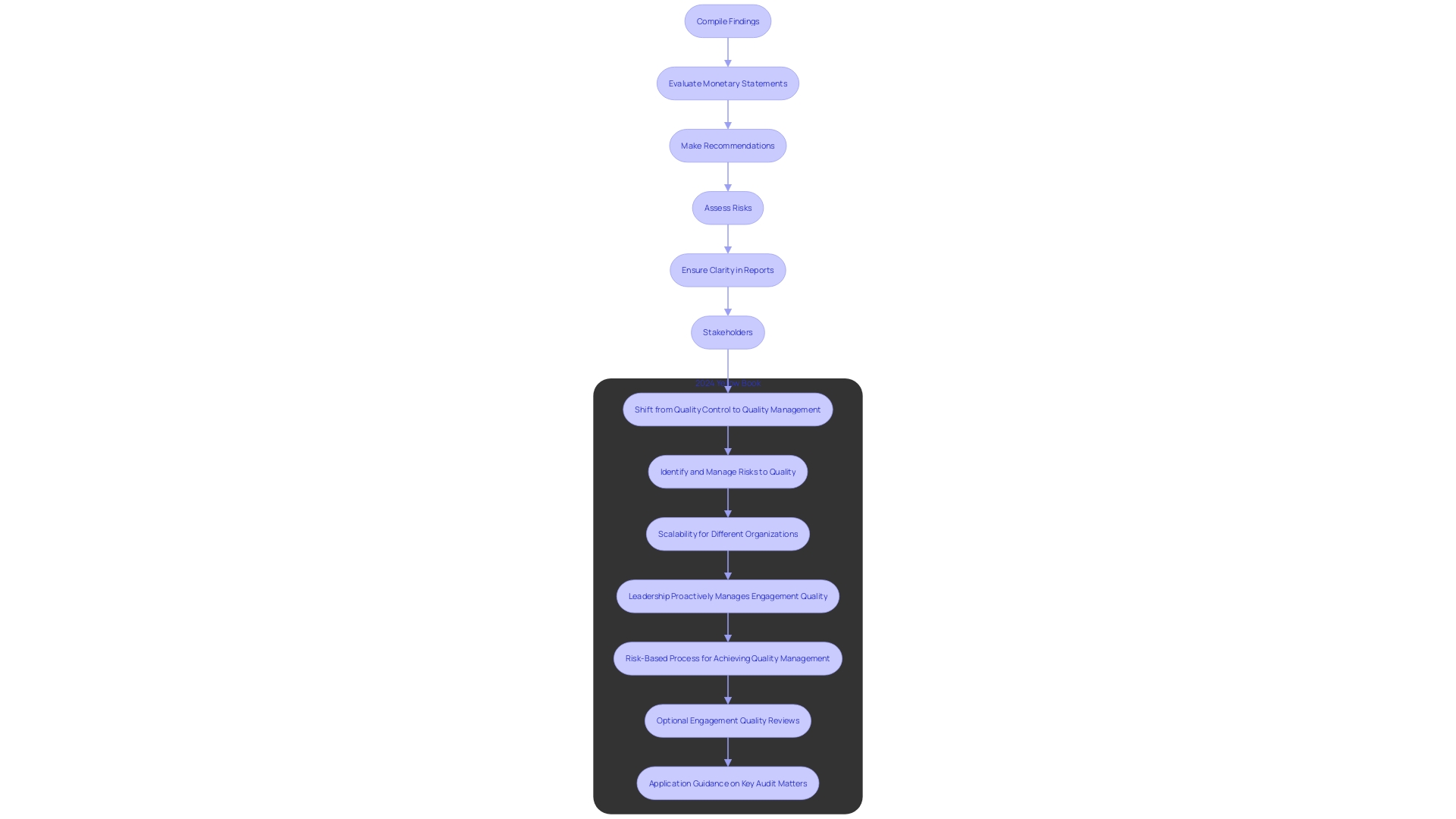
Post-Audit Follow-Up and Implementation of Recommendations
After the review, it is essential to respond to the auditor's suggestions to improve the entity's monetary practices. Implementing changes to internal controls and improving financial reporting processes are vital steps. Additionally, providing targeted training for staff ensures that everyone is equipped to maintain high standards. Regular follow-up not only ensures compliance but also promotes continuous improvement within the organization. For instance, the International Auditing and Assurance Standards Board's introduction of the ISA for LCE underscores the importance of tailored approaches to auditing smaller entities, highlighting the need for specific and ongoing adjustments. An effective audit committee, supported by the right resources and training, plays a pivotal role in achieving these objectives, as emphasized in recent guidance from regulatory bodies.
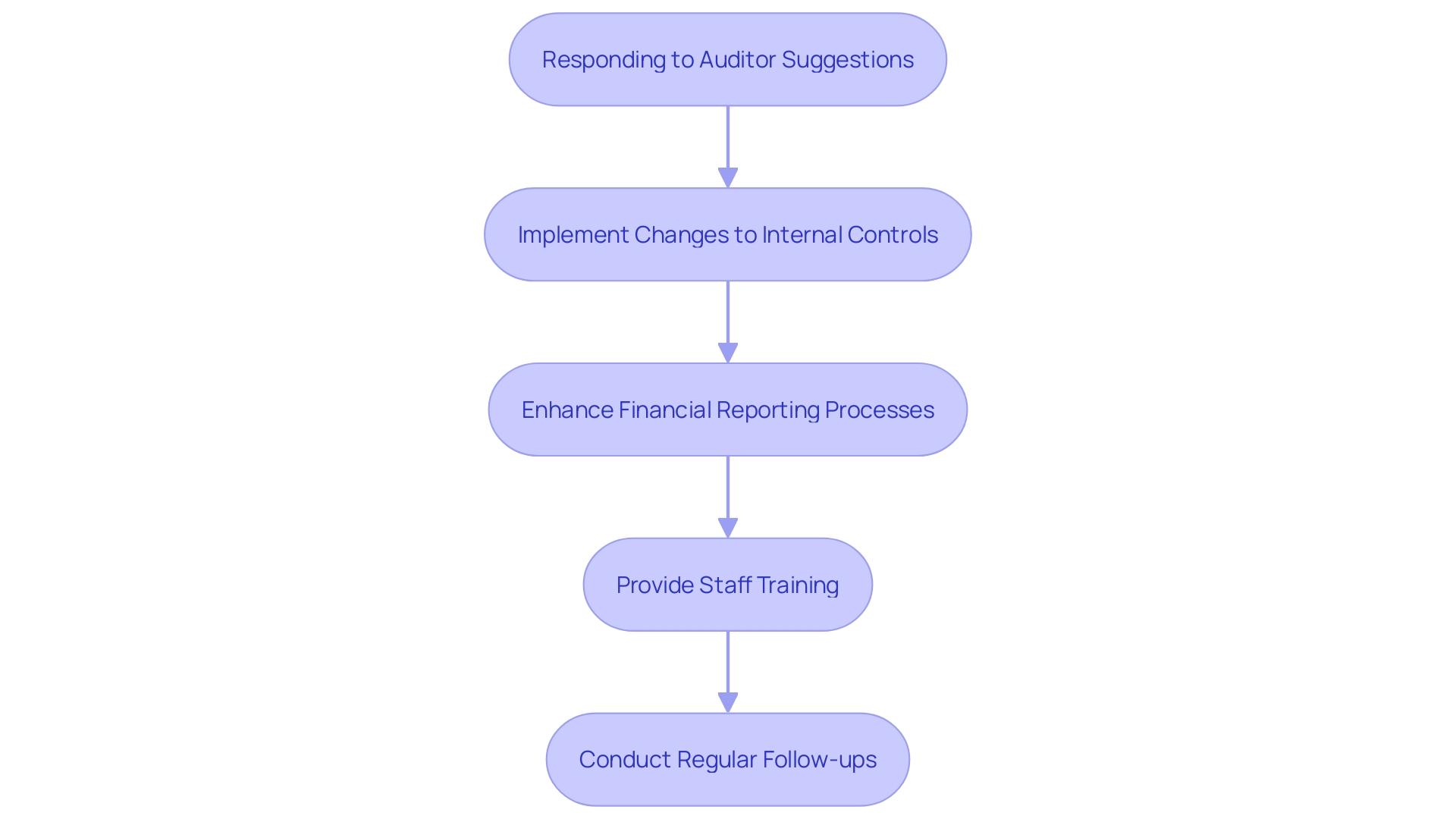
Conclusion
Financial audits are essential tools for ensuring transparency, compliance, and stakeholder trust within organizations. By providing rigorous examinations of financial statements and operations, these audits help identify inefficiencies and mitigate risks. The introduction of standards like the ISA for LCE specifically addresses the needs of smaller entities, ensuring they benefit from the same level of assurance as larger organizations.
Preparation is key to a successful audit process. Organizing financial records, reviewing internal controls, and preparing teams play critical roles in facilitating a smooth audit. Effective communication with auditors and proactive engagement throughout the audit phases—planning, execution, and reporting—enhance the overall quality of the audit.
Ultimately, the effectiveness of financial audits hinges on a commitment to continuous improvement and adaptation to regulatory changes. Organizations that prioritize thorough preparation and responsive practices not only navigate audits more effectively but also bolster their financial integrity and governance, fostering trust among stakeholders. Emphasizing these best practices will lead to more robust financial health and operational success in the long run.




